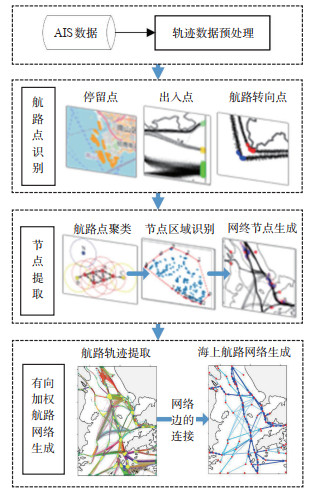A Method of Constructing Maritime Route Network Based on Ship Trajectory Mining
-
摘要: 海上航路网络是船舶海上交通活动特征的时空表征,也是船舶航路规划、行为辨识、轨迹预测的重要基础。海量的船舶历史轨迹数据为自动提取海上航路网络提供了基础数据,但受轨迹数据噪声和密度分布不均匀的影响,传统航路网络自动提取方法存在网络节点识别准确性差、网络边连接错误率高等问题。针对上述问题,研究了1种基于船舶轨迹时空特征挖掘的海上航路网络自动构建方法。定义了海上航路网络的3种航路点类型,即停留点、出入点和航路转向点,设计了基于轨迹时空特征的航路点提取方法;提出了基于累计转向特征的航路转向点过滤策略,可有效去除船舶避碰、船舶徘徊等局部活动产生的非航路转向点;根据不同种类航路点的分布特征,综合利用DBSCAN聚类算法和凸包算法从航路点集合中提取和生成航路网络节点集合;定义了航路网络节点的有效连接规则,从原始轨迹中提取航路网络节点之间的轨迹簇,根据轨迹簇的统计特征生成航路网络节点之间的有向加权边,形成有向加权的海上航路网络。以珠江口水域为实验区域,对所提方法进行有效性验证,结果表明:所提方法可提取71个3类航路网络节点和200条航路路线;航路网络节点识别准确率与误识别率分别为86.42%和1.23%;航路网络边连接的准确率接近95%。所提方法能够有效识别海上航路的关键航路点及主要路线,实现航路网络的自动构建。Abstract: The Maritime Route Network (MRN) is a spatiotemporal representation of maritime traffic characteristics and serves as a fundamental basis for ship route planning, behavior identification, and trajectory prediction. The vast amount of historical ship trajectory data provides foundational information for the automatic construction of the MRN. However, traditional automatic construction methods are hindered by poor accuracy in recognizing network nodes and a high error rate in connecting network edges due to trajectory data noise and uneven density distribution. To address these issues, this study proposes an automatic construction method for the MRN based on mining the spatiotemporal characteristics of ship trajectories. Three types of waypoints in the MRN are defined: stop points, entry/exit points, and route turning points. A waypoint extraction method based on trajectory spatiotemporal characteristics is designed. Additionally, a route turning point filtering strategy based on cumulative turning characteristics is proposed to effectively remove the non-route turning points caused by local activities such as ship collision avoidance and ship loitering. According to the distribution characteristics of different types of waypoints, a combination of the density-based spatial clustering of applications with noise (DBSCAN) clustering algorithm and the convex hull algorithm is applied to extract and generate the set of MRN nodes from the waypoints set. Based on the definition of effective connection rules for the MRN nodes, the trajectory clusters between the MRN nodes are extracted from the original trajectories. The directed weighted edges between the MRN nodes are generated based on the statistical characteristics of trajectory clusters to form a directed weighted MRN. The proposed method is validated in the Pearl River Estuary area. The results indicate that the method can extract 71 MRN nodes of the three types and 200 routes. The recognition accuracy and misrecognition rate of the MRN nodes are 86.42% and 1.23%, respectively, while the accuracy rate of the MRN edge connections is nearly 95%. The proposed method effectively identifies the critical waypoints and main routes in the maritime routes and realizes the automatic construction of the MRN.
-
表 1 转向点分区聚类参数
Table 1. Turning point partition clustering parameters
密度区域 eps/m MinPts 高 500 150 中 500 50 低 800 20 表 2 各等级航路航次范围
Table 2. Range of voyages for each class of routes
航路等级 航次范围/次 主干航路 (180, ∞) 次干航路 (90, 180] 分支航路 (25, 90] 次支航路 [10, 25] 表 3 不同方法的节点提取实验对比结果
Table 3. Comparative results of node extraction experiments using different methods
构建方法 节点类型 Nide Nmis Nun dnp/m Racc/% Rmis /% 本文方法 停留 9 0 1 379.92 90 0 出入 14 0 0 136.79 100 0 航路转向 48 1 10 282.30 82.46 1.75 全部节点 71 1 11 266.65 86.42 1.23 文献[6]方法 停留 10 4 4 1582.92 60 40 出入 14 0 0 157.84 100 0 航路转向 42 4 19 568.38 66.67 7.02 全部节点 66 8 23 635.02 71.60 9.87 文献[10]方法 停留 6 0 4 793.68 60 0 出入 13 0 1 288.98 92.86 0 航路转向 43 4 18 939.53 68.42 7.02 全部节点 62 4 23 789.01 71.60 4.94 -
[1] MOU N, LIU C, ZHANG L, et al. Spatial pattern and regional relevance analysis of the maritime silk road shipping network[J]. Sustainability, 2018, 10(4): 1-13. [2] WANG Z, CLARAMUNT C, WANG Y. Extracting global shipping networks from massive historical automatic identification system sensor data: A bottom-up approach[J]. Sensors, 2019, 19(15): 3363. doi: 10.3390/s19153363 [3] 于海宁, 张宏莉, 余翔湛. 交通网络拓扑结构及特性研究综述[J]. 华中科技大学学报(自然科学版), 2012, 40(增刊1): 274-279. doi: 10.13245/j.hust.2012.s1.007YU H N, ZHANG H L, YU X Z. A survey on transportation network topology and its properties[J]. Journal of Huazhong University of Science and Technology(Natural Science Edition), 2012, 40(S1): 274-279. (in Chinese) doi: 10.13245/j.hust.2012.s1.007 [4] PALLOTTA G, VESPE M, BRYAN K. Vessel pattern knowledge discovery from AIS data: A framework for anomaly detection and route prediction[J]. Entropy, 2013, 15(6): 2218-2245. [5] VESPE M, VISENTINI I, BRYAN K, et al. Unsupervised learning of maritime traffic patterns for anomaly detection[C]. 9th IET Data Fusion & Target Tracking Conference, London, United Kingdom: IET, 2012. [6] VARLAMIS I, KONTOPOULOS I, TSERPES K, et al. Building navigation networks from multi-vessel trajectory data[J]. GeoInformatica, 2021(25): 69-97. [7] KONTOPOULOS I, VARLAMIS I, TSERPES K. A distributed framework for extracting maritime traffic patterns[J]. International Journal of Geographical Information Science, 2021, 35(4): 767-792. doi: 10.1080/13658816.2020.1792914 [8] COSCIA P, BRACA P, MILLEFIORI L M, et al. Multiple Ornstein-Uhlenbeck processes for maritime traffic graph representation[J]. IEEE Transactions on Aerospace and Electronic Systems, 2018, 54(5): 2158-2170. doi: 10.1109/TAES.2018.2808098 [9] FILIPIAK D, WĘCEL K, STRÓŻYNA M, et al. Extracting maritime traffic networks from AIS data using evolutionary algorithm[J]. Business & Information Systems Engineering, 2020, 62(5): 435-450. [10] LU N, LIANG M, ZHENG R, et al. Historical AIS data-driven unsupervised automatic extraction of directional maritime traffic networks[C]. 5th International Conference on Cloud Computing and Big DataAnalytics, Chengdu, China: IEEE, 2020. [11] RONG H, TEIXEIRA A P, SOARES C G. Data mining approach to shipping route characterization and anomaly detection based on AIS data[J]. Ocean Engineering, 2020(198): 106936. [12] ZHANG S K, SHI G Y, LIU Z J, et al. Data-driven based automatic maritime routing from massive AIS trajectories in the face of disparity[J]. Ocean Engineering, 2018, 155(MAY 1): 240-250. [13] YAN Z J, XIAO Y J, CHENG L, et al. Exploring AIS data for intelligent maritime routes extraction[J]. Applied Ocean Research, 2020(101): 102271. [14] DOBRKOVIC A, IACOB M, van HILLEGERSBERG J. Maritime pattern extraction and route reconstruction from incomplete AIS data[J]. International journal of Data science and Analytics, 2018(5): 111-136. [15] PRASAD P, VATSAL V, CHOWDHURY R R. Route extraction and automatic information system(AIS)spoofing detection[C]. 2021 International Conference on Advances in Electrical, Computing, Communication and Sustainable Technologies, Bhilai, India: IEEE, 2021. [16] XIAO Z, PONNAMBALAM L, FU X, et al. Maritime traffic probabilistic forecasting based on vessels' waterway patterns and motion behaviors[J]. IEEE Transactions on Intelligent Transportation Systems, 2017, 18(11): 3122-3134. doi: 10.1109/TITS.2017.2681810 [17] XIAO Z, FU X J, ZHANG L, et al. Traffic pattern mining and forecasting technologies in maritime traffic service networks: A comprehensive survey[J]. IEEE Transactions on Intelligent Transportation Systems, 2019, 21(5): 1796-1825. [18] 黄亮, 刘益, 文元桥, 等. 基于航行经验的内河稀疏AIS轨迹估计方法[J]. 大连海事大学学报, 2017, 43(3): 7-13. https://www.cnki.com.cn/Article/CJFDTOTAL-DLHS201703002.htmHUANG L, LIU Y, WEN Y Q. Inland waterway sparse AIS trajectory estimation method based on navigation experience[J]. Journal of Dalian Maritime University, 2017, 43(3): 7-13. (in Chinese) https://www.cnki.com.cn/Article/CJFDTOTAL-DLHS201703002.htm [19] 黄亮, 张治豪, 文元桥, 等. 基于轨迹特征的船舶停留行为识别与分类[J]. 交通运输工程学报, 2021, 21(5): 189-198.HUANG L, ZHANG Z H, WEN Y Q. Stopping behavior recognition and classification of ship based on trajectory characteristics[J]. Journal of Traffic and Transportation Engineering, 2021, 21(5): 189-198. (in Chinese). [20] PHU Q, NGUYEN V, DO T, et al. PHU Q N P, Nguyen V, Do T, et al. Measuring crowd collectiveness with trajectory smoothing[C]. 1st International Conference on Multimedia Analysis and Pattern Recognition, Ho Chi Minh City, Vietnam: IEEE, 2018. [21] 刘立群, 吴超仲, 褚端峰, 等. 基于Vondrak滤波和三次样条插值的船舶轨迹修复研究[J]. 交通信息与安全, 2015, 33 (4): 100-105. doi: 10.3963/j.issn1674-4861.2015.04.016LIU L Q, WU C Z, CHU D F, et al. A study of ship trajectory restoration based on vondrak filtering and cubic spline interpolation[J]. Journal of Transport Information and Safety, 2015, 33(4): 100-105. (in Chinese). doi: 10.3963/j.issn1674-4861.2015.04.016 [22] ESTER M, KRIEGEL H P, SANDER J, et al. A density-based algorithm for discovering clusters in large spatial databases with noise[C]. The 2nd International Conferenceon Knowledge Discovery and DataMining, Portland, USA: AAAI Press, 1996. -





 下载:
下载:













